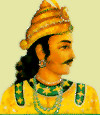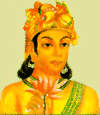Duration and Leaders
The mauryan empire lasted barley 200 years (322 BCE-185
BCE). Through these two centruies the Mauryan Empire was led by two great
rulers. The first of which would be the founder, Chandragupta
.
Chandragupta (322 BCE-296 BCE) came to rule
much of North India when he overthrew the last of the Nanda kings and captured
their capital city of Pataliputa. Next he went after northwestern India
where a power vacuum had been left by the departure of Alexander the Great.
He acted and ruled much like a Macedonian conquerer. He took over the lands
east of the Indus and then what is now Central India. In 305 BC Chandragupta
pushed farther west into what is now Afghanistan. This showed how powerful
Chandragupta really was. Toward the end of his life, Chandragupta renounced
his throne and became an ascetic under the Jain saint Bhadrabahn. He ended
up killing himself due to self-starvation.(IndiaVisit)

Asoka (273 BCE-232 BCE) was the next great leader
of the Mauryan Empire. He was the grandson of Chandragupta and had about
the same or more influence on India. He was born in about 304 B.C. and became
the third king of the Mauryan dynasty after the death of his father, Bindusara.
His given name was Asoka but he assumed the title Devanampiya Piyadasi which
means "Beloved-of-the-Gods, He Who Looks On With Affection." There seems to
have been a two-year war of succession during which at least one of Asoka's
brothers was killed. In 262 B.C., eight years after his coronation, Asoka's
armies attacked and conquered Kalinga, a country that roughly corresponds
to the modern state of Orissa. The loss of life caused by battle, reprisals,
deportations and the turmoil that always exists in the aftermath of war so
horrified Asoka that it brought about a complete change in his personality.
It seems that Asoka had been calling himself a Buddhist for at least two years
prior to the Kalinga war, but his commitment to Buddhism was only lukewarm
and perhaps had a political motive behind it. But after the war Asoka dedicated
the rest of his life trying to apply Buddhist principles to the administration
of his vast empire. He had a crucial part to play in helping Buddhism to spread
both throughout India and abroad, and probably built the first major Buddhist
monuments. Asoka died in 232 B.C. in the thirty-eighth year of his reign.(IndiaVisit)
